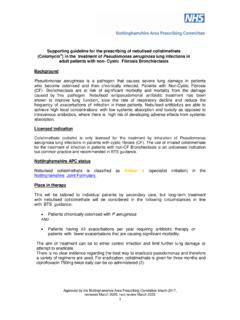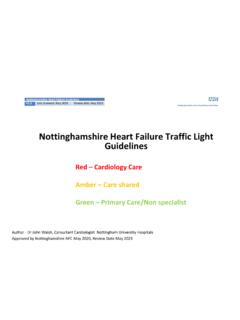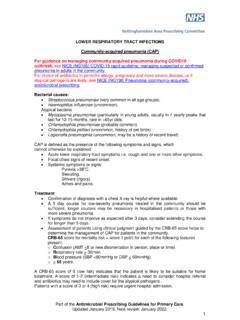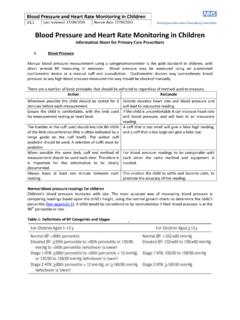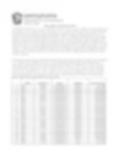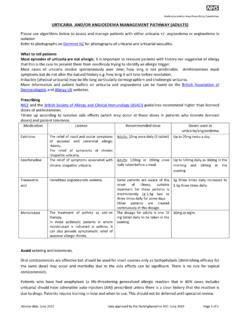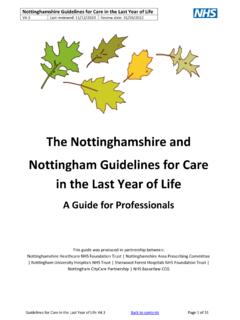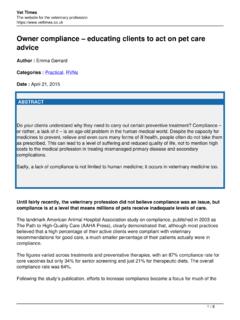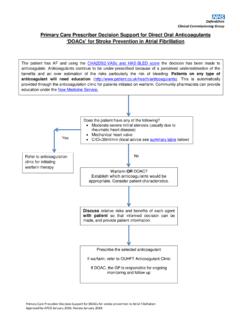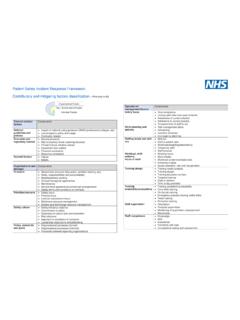Transcription of Atrial Fibrillation (Non-valvular): prescriber decision ...
1 Contents Assessing patients for anticoagulation in AF Page 2 Patient factors and anticoagulant choice Page 3 Checklist for initiation Page 4 Warfarin monitoring and reviewing Page 5 DOAC monitoring and reviewing Page 6 References Page 8 Appendix 1: Anticoagulation comparison table Page 9 Appendix 2: Warfarin Page 13 Appendix 3: Switching anticoagulation therapy (for AF only) Page 15 Appendix 4: Notes on HAS-BLED Page 17 Atrial Fibrillation (Non-valvular): prescriber decision support on anticoagulation Scope: This document is intended as prescriber decision support for prescribing anticoagulants for patients with non-valvular AF. The diagnosis and management of Atrial Fibrillation is beyond the scope of this document and prescribers are referred to the full NICE clinical guideline or NICE Pathway. As the decision to take an anticoagulant or not should be a patient level decision supported by information from the prescriber , this document is intended for use with the NICE patient decision aid (which presents information in a patient friendly format including CHA2DS2-VASc and HAS-BLED scores).
2 1 Anticoagulants_in_AF Last reviewed: January/2021 Review date: June/2022 Patient is a candidate for and consents to anticoagulation As per NICE CG180, anticoagulation may be with: oa vitamin K antagonist (warfarin) OR oone of the new oral anticoagulants (DOACs), edoxaban rivaroxaban, apixaban or dabigatran. oConsider referral if anticoagulation contraindicated or not tolerated See flowchart on page 3 below for individual patient factors to consider when choosing an anticoagulant. Based on the above assessment patient refuses or is not a candidate for anticoagulation Document decision in patient s notes and review annually, or when patient reaches 65 years old or if they develop any of the following at any age: oDiabetes, heart failure, peripheral arterial disease ocoronary heart disease ostroke, transient ischaemic attack or systemic thromboembolism. Do not offer aspirin monotherapy solely for stroke prevention to people with Atrial Fibrillation . However, patients on existing antiplatelet therapy for another indication may continue as necessary Assess the patient for anticoagulation using the below risk scores Assess stroke risk using CHA2DS2-VASc score Assess bleeding risk using HAS-BLED score Feature Score Feature Score Congestive Heart Failure 1 Hypertension (uncontrolled SBP >160mmHg) 1 Hypertension 1 Liver disease (Cirrhosis or bilirubin >2x normal with AST/ALT/ALP >3x normal) 1 Age >75 years 2 Renal disease (Dialysis, transplant, or >200 micromol/L) 1 Age between 65 and 74 years 1 Stroke history 1 Diabetes mellitus 1 Bleeding history or predisposition ( anaemia) 1 Stroke / TIA / Thrombo-embolism 2 Labile INRs ( Time in Therapeutic Range < 60%) 1 Vascular disease (previous MI, peripheral arterial disease or aortic plaque) 1 Elderly ( age > 65 years or frail condition) 1 Female 1 Drugs (concomitant antiplatelets, NSAIDs etc) or alcohol abuse (1 point each) 1 or 2 Score.
3 (maximum score of 9) Score: (maximum score of 9) Address modifiable risks where possible CHA2DS2-VASc score of 2 CHA2DS2-VASc score of 1 For most people the benefit of anticoagulation outweighs the bleeding risk. (Discuss with patient using the NICE patient decision aid for individualised charts explaining risks appropriate to the individual), but for people with an increased risk of bleeding ( HAS-BLED 3 see appendix 3) the benefit of anticoagulation may not always outweigh the bleeding risk, and careful monitoring of bleeding risk is important. Do not withhold warfarin solely because the person is at risk of having a fall. Consider specialist opinion Assessing patients for anticoagulation in AF CHA2DS2-VASc score of 0 2 (This guidance applies to patients with non-valvular paroxysmal, persistant or permanent AF, Atrial flutter or continuing risk of arrhythmia recurrence after cardioversion back to sinus rhythm) Offer anticoagulation taking bleeding risk into account Do not offer anticoagulation for stroke prevention in AF Consider for anticoagulation taking bleeding risk into account Men Women Does the patient have any of the following?
4 Significant (moderate or worse) mitral stenosis or prosthetic valves? Renal disease Creatinine clearance <30ml/min? (caution if borderline or at risk of acute kidney injury) Remains on concomitant interacting medicines? dronedarone, azole antifungals, HIV protease inhibitors, tacrolimus, ciclosporin, strong CYP3A4 inducers see summary table below Extremes of body weight (<50kg or >150kg) Poor concordance anticipated Consider WARFARIN (as DOACs either contraindicated, unlicensed or not recommended) Initiation of warfarin should be as per current pathway See initiation checklist below Does the patient have any of the following? Known unpredictable alcohol excess without established cirrhosis? Patient unable to comply with variable dose ( MUST be included in a compliance aid)? Significant difficulties with INR monitoring and/or accessing anticoagulant clinics that raises safety concerns (although consider local availability of domiciliary phlebotomy or near patient INR testing CoaguChek)?
5 Consider a DOAC (see table 1 below) (as warfarin either contraindicated, or not recommended) See initiation checklist below No Consider warfarin or a DOAC (see table 1 below or comparison table for other patient factors) See initiation checklist below From page 2: Patient is a candidate for and consents to anticoagulation to reduce the risk of stroke Discuss the options for anticoagulation with the person and base the choice on: oclinical features (see as per flowchart below) opatient preferences (see NICE patient decision aid available here) Baseline tests prior to initiation: U+Es (and Creatinine clearance (CrCl) calculated, DO NOT USE eGFR) FBC Clotting LFTs Weight Yes Yes No 3 If results of these tests are abnormal, investigate as appropriate prior to initiation of anticoagulation Anticoagulation choice and patient factors Table 1: Preferred choice of DOAC (based on patient factors) Where a DOAC is considered to be the most appropriate anticoagulant, edoxaban is to be used first line for patients with NVAF unless there is a specific clinical reason not to do so.
6 See Notts APC DOAC position statement. In line with NICE guidance, other DOACs can be considered. The following patient factors may suggest a preferred DOAC. Renal impairment Local specialists recommend avoiding DOACs (except apixaban) in patients with Creatinine Clearance (CrCL) <30mL/min due to increased risk of drug accumulation and bleeding. Apixaban has the lowest renal excretion percentage of all the DOACs and may be used at reduced dose ( BD) with caution if CrCL is <30mL/min and >15mL/min. See appendix 1 for more information of dosing. High creatinine clearance (>95ml/min) NOT edoxaban shows decreased efficacy at high creatinine clearance Increased bleeding risk (HAS-BLED 3) Apixaban Patient definitely requires compliance aid Edoxaban, Apixaban or Rivaroxaban (NOT dabigatran) Swallowing difficulties / enteral feeding tubes Apixaban, Rivaroxaban (both licensed) or Edoxaban (unlicensed) Patient with none of the above factors Edoxaban (as per Notts APC DOAC position statement), but see appendix 1 for other patient factors and interactions 4 Checklist and process for initiation of all anticoagulants: Initiation points Completed by / date.
7 Inform the patient of indication for the new medicine, dose, frequency, duration of therapy Emphasise importance of concordance to therapy especially with shorter acting agents (DOACs) Discuss possible undesirable effects Inform patient what to do if they miss a dose Discuss what to do in the event of injury / bleeding Advise patient to inform all healthcare professionals and to discuss OTC medicines with pharmacist (avoid aspirin/NSAIDs) Provide patient with an alert card (see formulary or manufacturer) Recommend the patient to discuss this new medicine with their pharmacist as part of the free new medicines service WARFARIN DOACs Initiation Warfarin should be initiated as per local pathway (traffic light classification GREEN) Initiation DOACs may be initiated by a primary care prescriber or non-specialist in secondary care (traffic light classification AMBER 3). For dose and frequency see individual drug in Appendix 1 South Nottinghamshire and NUH: Patient may be referred to local anticoagulant service for counselling if clinician and patient feel this would be beneficial Monitoring For warfarin see monitoring and reviewing section here Monitoring For DOACs see monitoring and reviewing section here Review Review the need for and quality of anticoagulation at least annually or more frequently if clinically relevant events occur affecting anticoagulation or bleeding risk Review Review the need for and quality of anticoagulation at least annually or more frequently if clinically relevant events occur affecting anticoagulation or bleeding risk Warfarin monitoring and reviewing Reviewing warfarin patients: Once stabilised review time in therapeutic range (TTR) at each visit.
8 The usual therapeutic range for AF patients is an INR of 2-3. Reviews should be done by the service monitoring and dosing the patient as per the following: use a validated method of measurement such as the Rosendaal method for computer-assisted dosing or proportion of tests in range for manual dosing exclude measurements taken during the first 6 weeks of treatment calculate TTR over a maintenance period of at least 6 months Continue dose adjusted warfarin Review patient s risk of stroke and bleeding risk at annual review TTR 65% Do any of the following apply?: Intolerance or allergy to vitamin K antagonists ( warfarin or acenocoumarol) History of significant bleed associated with poor warfarin control Patient has had in the last 6 months: 1 x INR >8 or 2 x INR > 5 or 2 x INR < TTR < 65% Take into account and address where possible: cognitive function adherence to prescribed therapy Illness interacting drug therapy lifestyle factors including diet and alcohol consumption Consider self-monitoring as per NICE Guidance if concordance affected by inconvenience of INR testing Reassess at appropriate time interval to assess improvement in control if measures put in place NO YES 5 Baseline blood tests Patient group U + Es (Creatinine clearance) Full blood count Coagulation screen Liver function tests All Follow up tests Patient group International Normalised Ratio (INR) All As required or as per protocol for self monitoring patients In addition to adequate clinical surveillance, laboratory testing of haemoglobin/haematocrit could be of value to detect occult bleeding, as judged to be appropriate If poor anticoagulation control cannot be improved: discuss risks and benefits of alternative strategies with the patient.
9 Exclude all reasons for poor INR control despite good compliance before considering a DOAC. Inform local anticoagulation service if switching therapy Refer to Appendix 2 for information about practicalities of switching between anticoagulants and initiation checklist Improved control? ( TTR 65%) NO YES Clinical trials have demonstrated that the therapeutic anticoagulation effect of DOACs does not require routine monitoring. Unlike warfarin, a prothrombin time may not be sensitive to their anticoagulant effect. Likewise an INR will not demonstrate the level of anticoagulation. As DOACs are predominantly eliminated by the renal route, it is prudent to monitor the renal function of a patient taking a DOAC. The following regimen is broadly in line with NICE guidance on Chronic Kidney Disease and based on consensus clinician opinion. This may recommend more frequent monitoring than that advised in the manufacturer s summary of product characteristics.
10 Initial clinical trials only included patients between 50kg and 120kg, but there is increasing evidence that these medications can safely be used up to 150kg19,20,21,22 Local consensus is that: Creatinine clearance must be used for calculating renal function using the Cockroft and Gault equation (see below). eGFR is not a suitable alternative: CrCl (ml/min)=(140 age) x wt (kg) x (female) or (male) serum creatinine (micromol/l) NB The clinical systems used in Nottinghamshire in primary care (SystmOne and EMIS) have an inbuilt Cockcroft-Gault based renal function calculator which can be used to dose DOACs. Both systems use ideal body weight (IBW) if actual body weight is greater than 120% IBW. The most up to date values for the patient s actual body weight and height will have to be inserted. These calculators make adjustments for a body mass index that is outside normal ranges and may produce a slightly different result to the equation provided. Controversy exists over which form of weight to use (actual BW, ideal BW, lean BW or adjusted BW).
